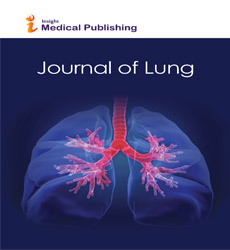Hypoxia and Interleukin-6 Exacerbate Blood Coagulation in COVID-19 Patients
Rinku Majumder*, Logan Barrios and Verima Pereira
1Department of Biochemistry and Molecular Biology, LSU Health Sciences Center, New Orleans, USA
- *Corresponding Author:
- Rinku Majumder, Department of Biochemistry and Molecular Biology, LSU Health Sciences Center, New Orleans, USA E-mail: rmajum@lsuhsc.edu
Received Date: June 07, 2021; Accepted Date: June 21, 2021; Published Date: June 28, 2021
Citation: Majumder R, Barrios L, Pereira V (2021) Hypoxia and Interleukin-6 Exacerbate Blood Coagulation in COVID-19 Patients. J Lung Vol.2 No. 4: 7
Description
A hallmark of Coronavirus disease 2019 (COVID-19) is abnormalities in coagulation associated with upregulations in procoagulants that are indicators of high mortality [1]. Critical illness is the main contributor to death due to COVID-19. COVID-19 has a multitude of comorbidities that vary among patients and with the severity at which they experience the virus. However, a common COVID-19 comorbidity is respiratory insufficiency resulting in hypoxemia [2]. Hypoxemia increases the risk of thrombosis because of interference in regulation of blood coagulation [3].
Coagulation is quite common in severely ill COVID-19 patients [4]. Coagulation is tightly regulated by the clotting factors, co- factors, and inhibitors that are associated with the control of the crucial enzyme thrombin [5]. Hemostasias is a physiological state that aids to maintain and promote blood flow and prevents coagulation under normal circumstances. Conversely, in the event of an injury to a blood vessel, to minimize blood loss, a cascade of coagulation events takes place to maintain normal blood flow through the lumen of the damaged vessel [6].
Protein S (PS) has a key anticoagulation function in hemostasis. Protein S is a 70-kDa vitamin K dependent plasma glycoprotein that circulates at a concentration of approximately 25 mg/L (0.30 g) in human plasma [6]. Hepatocytes are the major producer of PS, but megakaryocytes, endothelial cells, Leydig cells of testis, osteoblasts, and vascular smooth muscle cells also synthesize PS [7,8]. Protein S inhibits factor IXa of the coagulation pathway; this inhibition limits the production of factor Xa and, in turn, limits thrombin formation.
Protein S levels in COVID-19 patients have been overlooked in diagnosis and prognosis. Protein S levels are an important indicator of thrombotic risk and other disease complications. Decreased PS level are associated with hypoxic conditions. Hypoxia causes hypoxia inducible factor 1 alpha to downregulate PS expression, which results in an increased risk of thrombosis in hypoxic individuals [3]. Acute hypoxia is associated with severe COVID-19 disease because of lung injury and respiratory failure, which is the most common cause of death from COVID-19 [2].
In addition to hypoxia, the cytokine storm induced by interleukin 6 (IL-6) also downregulates PS levels in COVID-19 patients. Interleukin-6 is a proinflammatory cytokine that induces tissue factor (TF) gene expression in endothelial cells, which, in turn, increases thrombin generation. Because COVID-19 patients have elevated IL-6 levels they experience a higher thrombotic risk [2].
Chatterjee et al. demonstrated clearly that early immune response proinflammatory cytokines are induced and activate blood coagulation in COVID-19. This early immune response occurs by stimulation of TF expression in monocytes. Increased TF leads to the formation of thrombin through the TF-VIIa pathway of blood coagulation. The clot that is produced by this pathway becomes wedged in arteries in the lungs and leads to thrombotic complications and hypoxia. In COVID-19 disease, hypoxia induces IL-6 while thrombin leads to inflammation and accelerates the cytokine storm. The cytokine storm induced by IL-6 and hypoxia simultaneously downregulate PS, further inducing a severe risk of thrombosis [9]. Chatterjee et al. speculated that the IL6-driven cytokine explosion plus hypoxemia caused a severe drop in PS level to exacerbate the thrombotic risk in COVID-19 patients. Thus, clinicians should monitor PS levels in COVID-19 patients to prevent severe thrombotic complications and protect lung health. The inflammatory response of COVID-19 patients is a significant threat that increases the severity of the virus and further complicates the disease. To prevent these additional complications, research is urgently needed to identify therapies that would combat the duo of the cytokine storm inflammatory response and hypoxia and upregulate PS.
References
- Zheng R, Zhou J, Song B, Zheng X, Zhong M, et al. (2021) COVID-19-associated coagulopathy: thromboembolism prophylaxis and poor prognosis in ICU. Exp Hematol Oncol. 10:6.
- Ranucci M, Ballotta A, Di Dedda U, Bayshnikova E, Dei Poli M, et al. (2020) The procoagulant pattern of patients with COVID-19 acute respiratory distress syndrome. Observational Study. 18:1747-1751.
- Pilli VS, Datta A, Afreen S, Catalano D, Szabo G, Majumder R. (2018) Hypoxia downregulates protein S expression. Blood. 132: 452-455.
- Rette A, Barrett NA. (2015) The management of abnormal haemostasis in the ICU. Anaesthesia. 70: 121-7.
- Palta S, Saroa R, Palta A. (2014) Overview of the coagulation system. Indian J Anaesth. 58: 515-23.
- Marietta M, Ageno W, Artoni A, De Candia E, Gresele P, et al. (2020) COVID-19 and haemostasis: a position paper from Italian Society on Thrombosis and Haemostasis (SISET). Practice Guideline. 18: 167-169.
- DiScipio RG, Davie EW. (1979) Congenital extrahepatic portocaval malformation: Rare but potentially treatable cause of pulmonary hypertension. Biochemistry. 18: 899-904.
- DahlbaÌ?ck B. (1991) Protein S and C4b-binding protein: components involved in the regulation of the protein C anticoagulant system. Thromb Haemost. 66: 49-61.
- Chatterjee S, Sengupta T, Majumder S, Majumder R. (2020) COVID-19: a probable role of the anticoagulant Protein S in managing COVID-19-associated coagulopathy. Aging (Albany NY. 18: 15954-15961.
Open Access Journals
- Aquaculture & Veterinary Science
- Chemistry & Chemical Sciences
- Clinical Sciences
- Engineering
- General Science
- Genetics & Molecular Biology
- Health Care & Nursing
- Immunology & Microbiology
- Materials Science
- Mathematics & Physics
- Medical Sciences
- Neurology & Psychiatry
- Oncology & Cancer Science
- Pharmaceutical Sciences
